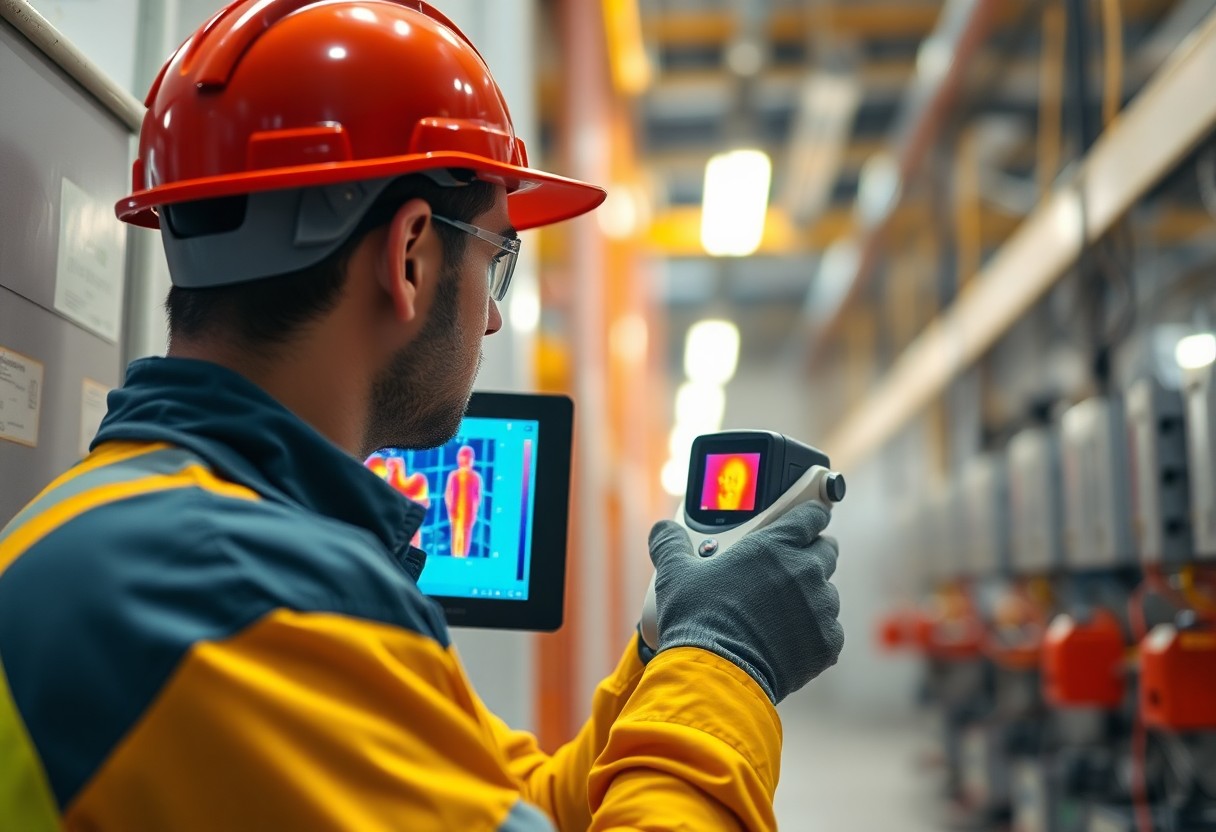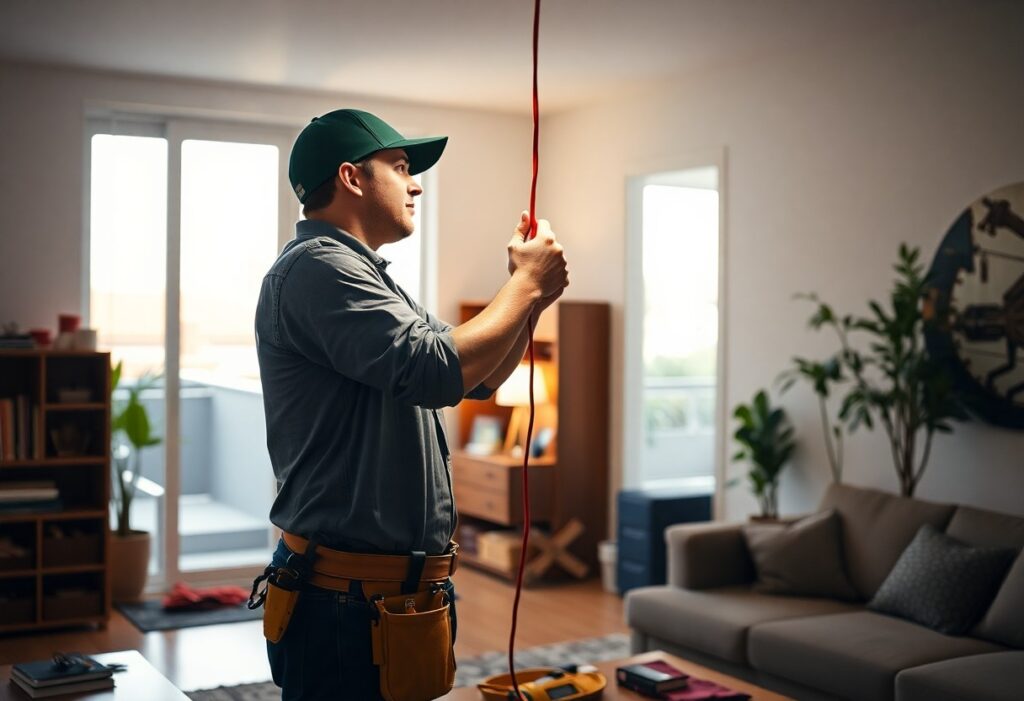It’s vital to understand how infrared testing can safeguard your electrical systems from unexpected failures that could lead to significant expenses. This non-invasive technique allows you to identify heat anomalies in electrical components, revealing potential faults before they escalate into major issues. By integrating infrared testing into your maintenance routine, you empower yourself to enhance system reliability and reduce costly downtime. Join us as we explore the benefits of this innovative testing method and how it can ultimately protect your investments.
Key Takeaways:
- Infrared testing identifies hot spots and overheating components, enabling timely maintenance or repairs that can prevent unexpected failures.
- This non-invasive technique allows for regular monitoring of electrical systems without disrupting operations, significantly reducing downtime.
- Integrating infrared testing into routine inspections can enhance equipment longevity and efficiency, ultimately saving on costly repair and replacement expenses.

Understanding Infrared Testing
To fully appreciate the value of infrared testing, it’s necessary to understand what it entails. For a comprehensive overview, check out Infrared Electrical Inspection: A Complete Guide for Professionals. This guide explores how infrared testing identifies potential issues in electrical systems before they lead to failures.
Definition of Infrared Testing
About infrared testing; it involves using thermal imaging technology to detect heat patterns in electrical systems. By capturing infrared radiation emitted from objects, this method reveals temperature variations that could indicate malfunctioning components or connections.
The Science Behind Infrared Technology
Behind the effectiveness of infrared testing lies the principle that all objects emit infrared radiation based on their temperature. When you use an infrared camera, it translates these heat emissions into a visual format, allowing you to see temperature discrepancies that could signal problems.
At the core of this technology is the Stefan-Boltzmann law, which states that the amount of infrared radiation emitted increases significantly with temperature. This means, when you spot an area that is unusually hot, it’s a clear indicator that something may be amiss, whether it’s a loose connection, high resistance, or failing components. Understanding this science equips you to interpret thermal images effectively and address potential issues proactively.
Importance of Thermal Imaging in Electrical Maintenance
Importance of thermal imaging in electrical maintenance cannot be overstated. This method allows you to perform non-invasive inspections, ensuring you can identify potential issues without disrupting your operations.
Further exploring thermal imaging’s role in maintenance, it enhances your ability to schedule repairs before failures occur. By regularly monitoring with infrared technology, you can increase the reliability of your electrical systems and significantly reduce costly downtime. This proactive approach not only saves money but also ensures a safer working environment for everyone involved.
Electrical Failures: Causes and Consequences
Now, it’s vital to understand that electrical failures can stem from a variety of sources. Poor installation practices, worn-out components, environmental factors like moisture or dust, and lack of regular maintenance can all contribute to these issues. Additionally, overloaded circuits and equipment that exceed their designed capacity can lead to dangerous failures. Identifying these common causes early on can be instrumental in preventing incidents that may damage your electrical systems.
Common Causes of Electrical Failures
By evaluating your electrical system, you can discover common causes of failures. These include inadequate insulation, faulty wiring, loose connections, and equipment age. Over time, these factors can compromise system integrity, potentially leading to severe consequences.
Economic Impact of Electrical Failures
Against this backdrop, the economic implications of electrical failures can be significant. Losses may arise from downtime, repair costs, and decreased productivity, all of which can strain operational budgets and resources. Your organization may experience not only direct expenses but also reputational damage and lost business opportunities.
Consequently, the cascading effects of electrical failures can disrupt your workflow and lead to unanticipated expenses. Each malfunction can escalate into larger operational challenges, requiring extensive repairs and potentially causing business interruptions. Ensuring a smooth-running electrical system is vital for maintaining financial health and avoiding such setbacks.
Safety Risks Associated with Electrical Failures
On a more critical note, electrical failures often pose severe safety risks. They can lead to fires, electric shocks, or explosions, endangering not just your assets but also the lives of your employees and customers. Prioritizing safety in your electrical maintenance efforts is important for a secure working environment.
Failures like short circuits and overheating can escalate quickly, resulting in catastrophic events. It’s your responsibility to implement effective safety measures and constant monitoring to safeguard everyone. A proactive approach to identify and address potential risks will not only protect lives but also ensure the integrity of your business operations.
How Infrared Testing Works
For effective maintenance and safety in electrical systems, infrared testing utilizes advanced thermal imaging technology to identify hot spots that indicate potential issues. This non-invasive method allows you to detect problems before they escalate, ensuring reliability in your operations. For more insights, you can explore Infrared Insights: The Path to Preventing Electrical Failure ….
Equipment Used in Infrared Testing
Across the spectrum of infrared testing, specialized equipment plays a key role. You will typically see infrared cameras equipped with high-resolution sensors that capture thermal images, along with software tools that analyze and interpret temperature readings.
Process of Conducting Infrared Inspections
Between preparing the site and analyzing the results, the process of conducting infrared inspections involves multiple steps to ensure accurate readings. The inspection begins with a thorough assessment of the electrical components to be tested.
Conducting infrared inspections generally entails carefully scanning electrical panels, connections, and equipment while they are in operation. This live testing is what makes infrared technology so effective, as it provides real-time data about the thermal performance of your electrical systems. Once you have collected thermal images, they are reviewed and documented to highlight any irregularities that require further attention.
Interpreting Infrared Images
Equipment plays an necessary role in interpreting infrared images. By using thermal imaging software, you can gain insights into temperature variations and identify areas that may be problematic.
Another important aspect of interpreting infrared images involves understanding the thermal patterns that indicate electrical anomalies. Familiarity with normal temperature ranges for the equipment is critical, as deviations can signify underlying issues. Analyzing these images allows you to make informed decisions about necessary maintenance and repairs, ultimately helping you avoid costly electrical failures.
Benefits of Infrared Testing in Electrical Maintenance
After understanding the importance of infrared testing, you can explore its key benefits in electrical maintenance. This method not only identifies issues but also enhances operational efficiency and safety across your systems.
Early Detection of Potential Failures
At the forefront of infrared testing is its ability to spot potential failures even before they occur. By identifying overheating components, you can prevent unexpected breakdowns that could disrupt your operations.
Reducing Downtime and Maintenance Costs
About reducing downtime, infrared testing allows for timely interventions that minimize unexpected outages. When you address issues early, you can schedule repairs during non-peak hours, thereby optimizing your workforce and resources.
Further, by preventing unplanned failures, you can significantly cut maintenance costs. Traditional repair methods might lead to longer downtimes and more expensive fixes. With infrared testing, you gain a clearer picture of equipment health, allowing for targeted actions that save both time and money.
Enhancing System Reliability and Safety
For enhancing system reliability, infrared testing plays a vital role in ensuring your electrical systems perform optimally. By regularly monitoring equipment, you can identify anomalies that might lead to malfunctions, thus improving overall system integrity.
Early detection of potential issues through infrared technology enhances safety within your facility. By addressing thermal irregularities, you can reduce the likelihood of equipment failures that could jeopardize your team or property, fostering a safer working environment.
Case Studies: Infrared Testing in Action
Your understanding of how infrared testing can prevent costly electrical failures is enriched by real-world applications. Below are several case studies highlighting the effectiveness of infrared inspections across different industries:
- Case Study #1: A manufacturing plant reported a 25% reduction in electrical faults after implementing infrared testing, leading to a yearly savings of approximately $50,000 in repair costs.
- Case Study #2: A commercial office building underwent an infrared inspection that uncovered seven faulty circuit connections, which could have caused significant downtime. The estimated cost of that downtime was around $75,000.
- Case Study #3: A utility provider used infrared testing on transformers, which identified thermal anomalies that, if left unchecked, would have resulted in catastrophic failures. This led to an avoided loss of over $1 million in equipment replacement.
- Case Study #4: A retail chain used infrared inspections on its extensive lighting systems, preventing an anticipated energy expense increase of 15%, saving around $120,000 annually.
For more insights into the benefits of infrared testing, you can check out the 5 Benefits of an Infrared (IR) Electrical Inspection.
Manufacturing Sector Applications
Against the backdrop of complex machinery and high production demands, manufacturing facilities cannot afford electrical failures. Infrared testing has been a game-changer, allowing for predictive maintenance and ensuring uptime continuity.
Commercial Building Inspections
Commercial buildings depend on reliable electrical systems for everything from lighting to HVAC operations. Commercial properties that integrate infrared testing benefit from early detection of issues that could lead to high repair costs and operational disruptions.
Plus, routine infrared inspections in commercial buildings have proven to significantly reduce energy inefficiencies. By identifying thermal leaks and faulty wiring, inspectors help businesses maintain optimal performance levels, reducing long-term operational costs.
Utility and Power Distribution Examples
By applying infrared testing in utility and power distribution systems, companies can proactively identify overheating components, thereby mitigating risks of failure that could lead to widespread outages.
Distribution networks that utilize infrared technology not only enhance safety but also extend the lifespan of equipment. Identifying issues before they escalate allows utilities to manage resources better, leading to improved service reliability and reduced maintenance expenditures.
Best Practices for Implementing Infrared Testing
Despite the significant advantages that infrared testing offers, its effectiveness largely depends on how well it is implemented in your organization. To maximize the benefits, you should consider several best practices that fit your operational needs and maintenance goals. This includes developing a comprehensive schedule, integrating infrared testing into your preventive maintenance plans, and ensuring proper training and certification for your technicians.
Developing a Comprehensive Schedule
Any effective infrared testing program begins with a detailed schedule that outlines when inspections will take place. By meticulously planning these assessments, you can take proactive steps to monitor equipment under various operating conditions and ensure that no critical component is overlooked. Regular intervals can help you maintain optimal performance and reduce the risk of failures.
Integrating Infrared Testing into Preventive Maintenance Plans
Into your preventive maintenance plans, infrared testing serves as an exceptional diagnostic tool that allows you to catch potential issues before they escalate. By supplementing regular maintenance checks with infrared inspections, you provide your assets with an added layer of protection. This proactive approach helps you make informed decisions regarding repairs and replacements, ultimately saving you time and money.
This synergy between infrared testing and preventive maintenance creates a comprehensive strategy for asset management. Incorporating thermal imaging into your routine inspections allows you to identify temperature anomalies that may signal impending failures. This not only extends the lifespan of your equipment but also enhances overall system reliability, keeping your operations running smoothly.
Training and Certification for Technicians
Between the success of your infrared testing program and the expertise of your technicians lies training and certification. Your team members should be equipped with the necessary skills and knowledge to conduct thorough inspections and interpret the thermal images accurately. With the right training, they can recognize potential issues and respond effectively, enhancing your overall electrical safety protocol.
Also, investing in ongoing training and certification ensures that your technicians stay updated with the latest technologies and methodologies in infrared testing. This commitment not only increases their proficiency but also boosts their confidence in identifying problems, enabling you to achieve a higher standard of electrical maintenance. Regular workshops and certifications can significantly improve the effectiveness of your infrared testing program and contribute to your facility’s long-term success.
Future Trends in Infrared Testing
Many advancements are on the horizon for infrared testing, driven by technological innovations and expanded application areas. These trends promise to enhance your ability to identify potential issues before they lead to costly failures.
Innovations in Infrared Technology
Trends in infrared technology include the development of higher resolution thermal cameras and improved sensitivity. These enhancements enable you to detect minute temperature differences, making it easier to identify early signs of electrical failures or equipment malfunctions.
The Role of Artificial Intelligence in Infrared Analysis
Innovations in artificial intelligence are set to transform infrared analysis significantly. By integrating machine learning algorithms, you can gain more precise insights from thermal images, as AI can recognize patterns and anomalies that might go unnoticed by the human eye.
Plus, AI-driven software can reduce the time you spend analyzing thermal data by automating the identification of potential problems, allowing you to focus on strategic decision-making rather than data interpretation.
Expanding Applications Beyond Electrical Systems
One of the exciting trends is the expanding applications of infrared testing beyond traditional electrical systems. Industries such as manufacturing, healthcare, and building maintenance are increasingly adopting this technology to monitor equipment, assess building insulation, and conduct preventive maintenance.
To explore the expanded use of infrared technology, consider how these applications can improve efficiency and safety in your operations. By leveraging infrared testing in various contexts, you can enhance your maintenance strategy and potentially reduce operational costs across diverse systems.
FAQ
Q: What is infrared testing, and how is it applied to electrical systems?
A: Infrared testing, also known as thermography, is a non-destructive testing method that uses infrared cameras to detect heat patterns in electrical systems. By capturing thermal images, technicians can identify hotspots that indicate potential problems such as overloaded circuits, poor connections, or failing equipment. This method allows for a thorough examination of electrical components without interrupting operations, enhancing system reliability and safety.
Q: How does infrared testing help in preventing electrical failures?
A: Infrared testing helps prevent electrical failures by identifying abnormalities that could lead to equipment failure before they escalate into significant issues. By detecting excess heat associated with overloaded or failing components, maintenance teams can address these concerns proactively. This predictive maintenance strategy minimizes unexpected downtime and costly repairs by allowing organizations to schedule maintenance during routine inspections rather than responding to failures.
Q: What are the cost-saving benefits of using infrared testing for electrical systems?
A: Utilizing infrared testing can lead to substantial cost savings for businesses. By identifying problems before they become critical, organizations can avoid unplanned outages that disrupt operations and result in lost revenue. Additionally, proactive maintenance can extend the lifespan of electrical equipment and reduce repair expenses. Furthermore, catching issues early helps in preventing safety hazards that can lead to further financial liabilities, enhancing overall operational efficiency and safety standards.



